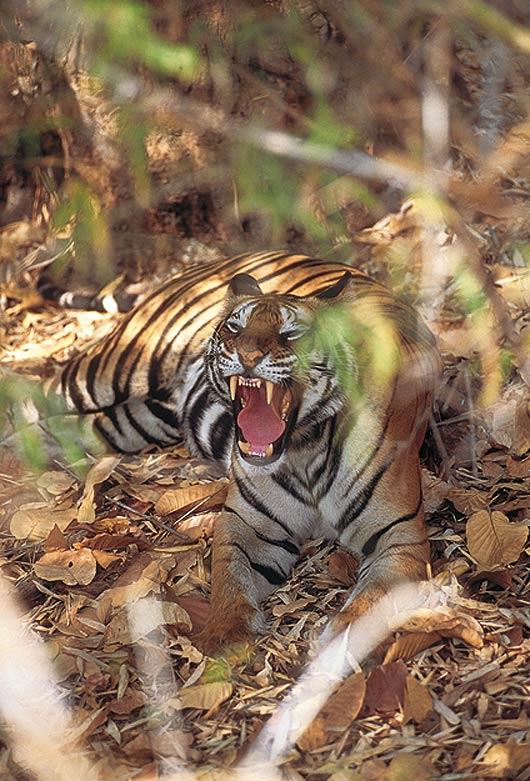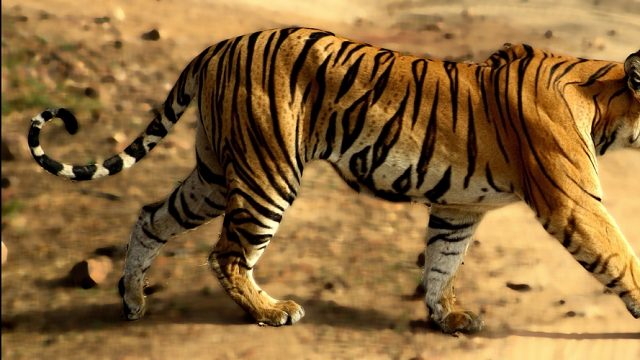A luminous jungle morning in Bandhavgarh. Mist and sun shafts hang around the thick sal trees. A scraggy
Suddenly, a convoy of Maruti Gypsys is upon us, raising dust all around. On the first, sprawled almost on the bonnet, is a large man in a monkey cap. As his vehicle screeches to a halt, he rears up and asks in a thick Bengali accent: “Hab you seen tiger?” We shake our heads. “We saw,” he says with gleeful emphasis. “Big male. Magnificent. We saw for full fifteen minutes.” Then, as his Gypsy swoops down the trail, he adds, almost with a touch of challenge: “Maybe you will also get to see.”
That was it. We had been sucked into the game of one-upmanship played out everyday in Bandhavgarh National Park. A game in which the winner can stick his tongue out and jump up and down shouting: “I saw the tiger…I saw the tiger.” Childish? Maybe. But right there, right then, it was deadly serious. The tranquil jungle moment was forgotten; everyone in our jeep was suddenly anxious. A whole convoy had seen the tiger—a magnificent male tiger — for fifteen minutes. When would we get our chance? What if we didn’t? Could we handle the trauma?
The point is, it’s hard to come here and go home without seeing a tiger. Hit the query: “Best place to see a tiger” on any search engine and Bandhavgarh will almost invariably pop up. It’s best explained statistically. Of the 4,000 tigers in the wild (experts squabble over this figure), the majority is in India. And, in India, the majority of tigers lives in Madhya Pradesh. And, in Madhya Pradesh…well, let me put it this way: if you don’t see a tiger in Bandhavgarh, never try to become a professional gambler.
Tigers are synonymous with Bandhavgarh and over the years there have been a fair share of celebrity tigers. One of them was Mohan, a white tiger cub found by the former Maharaja of Rewa in 1951. Today, almost all the white tigers in the world (all in captivity) owe their genes to Mohan. Another celebrity tigress named Sita (made famous by numerous documentaries) is known to have given birth to at least eighteen tigers and is literally the queen mother to most tigers here. And because of its scenic beauty — thick sal forests, rolling grasslands, rocky cliffs, bamboo groves — TV channels like National Geographic and Discovery keep churning out documentaries from these jungles. The result is an overdose of subliminal messages tattooed on the brain: Bandhavgarh expects you to see the tiger.
And that explains the pressure — not only on you, but also on those working in the service sector in and around the Park. On my first morning, the waiter who served breakfast wished me with what sounded like a standard greeting: “May you see tiger today sir!” But the backbone of the service sector in Bandhavgarh is the merry group of Gypsy drivers and forest guides, who by law accompany you as you go traipsing through the jungle — incredibly funny, cynical and often villainous guys who are wise to the ways of the park. Our driver was Upadhyay, a lithe, loopy soul with a quick laugh who mostly did not speak unless asked a direct question, and even then was likely to reply in the form of a question. The guides kept changing, but the one who accompanied us twice was Tej Pratap, a veritable talk show host compared to Upadhyay. He kept us riveted with trivia — like how termite mounds always lean to the northwest, or how leopards like to defecate and urinate at the same time.
But the pressure tells on them as well. Park authorities give out different routes to vehicles going into the Park, a move to ensure that traffic is distributed evenly. However, on the morning of our first foray into the jungle and three minutes into ‘Route C’, Upadhyay brought the jeep to a halt asking: “Do you want to see the tiger or do you want a joyride through the jungle?” Apparently, this is standard procedure. It assures them of two things: a good tip if the tiger is spotted, and minimal petrol usage since most routes wind all over the park. As soon as we had made our choice, Pratap came alive, shouting out directions to where the Park’s elephants had spotted a tiger this morning. We were off to our first ‘tiger show’.
Bandhavgarh has a system of arming its mahouts with walkie-talkies and sending out their elephant fleet to scour the jungles for a suitable tiger sighting. If a tiger is spotted, word quickly spreads, bringing vehicles inside the park to queue up for a show. We found ourselves the eleventh vehicle in line (we were even given a cardboard token). Three elephants continuously ferried tourists (for 60 rupees per head) to a spot where we were told were two adolescent tigers. After fifteen minutes, we were put upon a huge male elephant and taken to where we could see the cubs playing from a distance of about thirty feet. Over the next fifteen minutes, two other tourist-bearing elephants came and went. Cameras clicked. A child broke into a loud wail and was admonished even more loudly by his mother. But the cubs, oblivious of human presence, kept playing their own version of football with what seemed like a shaggy sambhar head. By the time we got back to our jeep, token no. 52 had just been given out.
I asked Tej Pratap if the tigers ever reacted to the tourists. “Most tigers here are habituated to humans,” he told me. They’ve grown used to tourists. But there have been exceptions — like a big testy male aptly called Charger because of his enthusiasm for charging and clawing up the back-end of tourist elephants, completely traumatising the visitors on board. After Charger died, the authorities instituted an annual Charger Cricket Tournament in his memory. Tej Pratap explained that there are three tigers, named B1, B2 and B3, in the Park’s tourist area who doggedly carve out carefully delineated territories. The tigresses that criss-cross these territories and mate with the males are usually shy, he added, but the males hold no grudges against humans.
He was right. The very next day we ran into B3. Upadhyay had been told strictly that this time we did want to stick to our allocated route — but another convoy of Gypsys shouting “tiger, tiger” and Tej Pratap’s imploring look had weakened our resolve. We turned a corner and ran smack into him. B3 was like a Hollywood star, sauntering through the foliage about ten metres from a jungle road jam-packed with at least fifty Gypsys full of swooning fans. Between B3 and the Gypsys, two jeeps driven by rangers were positioned like bouncers. When B3 passed us, he was so close I could hear his steady sonorous breathing. But the trouble began when he passed us and Upadhyay (like everyone else) tried to overtake the Gypsys ahead of us. Vehicles bumped into each other, verbal duels followed and curses were exchanged. But B3, ignoring all, kept walking on… We could as well have been at a zoo.
In our three-day visit, we had seen four tigers. The last sighting was pure chance. We had forced Upadhyay to drive us around the remote parts of the sanctuary and he and Tej Pratap seemed on edge. As we were descending a rocky part of the Vindhyas, Tej Pratap asked that the vehicle be stopped. At first, I thought it was a pact between him and Upadhyay to save fuel. But then it happened. We all heard the loud snap of a twig…and Tej Pratap whispered “tiger!”, shooting an index finger upwards. We turned to see a tigress on the hill opposite us about 300 yards away. The alien smell of humans had made her look back, and elicited a small warning snarl. Then, quietly, within seconds, she was lost in the foliage. It was an authentic, genuine wild moment that showed us what a tiger actually is — a solitary, secretive and powerful creature. And even if only for a few seconds, it was far more fulfilling than our jamboree sightings.
As we headed out, Upadhyay suddenly pressed on the accelerator. I didn’t see why till I saw a Gypsy with the same Bengali man sprawled with his feet on the bonnet. The monkey cap was gone, but the smug look was still there. As we pulled alongside, Upadhyay said to him: “We saw four tigers. Altogether for at least forty-five minutes.” We sped past, leaving him in a cloud of dust, his jaw unhinged. That felt good as well.
The Information
Getting there
The closest airport to Bandhavgarh is at Jabalpur (164km; Kingfisher flies from Delhi from Rs. 4,200 one-way). Umaria (32km), the nearest railway station, is connected to Delhi (Rs. 1,160 on 2A). From Mumbai, you could take a train to Jabalpur (Rs. 1,256 on 2A) and then drive down from there.
Where to stay
There are plenty of places to stay at in Tala, the village just outside the park. Try MPTDC’sWhite Tiger Forest Lodge (from Rs. 3,490 for doubles; 07627-265366, mptourism.com). More upscale is the Sarai at Toria (Rs. 12,000; 9685293130; saraiattoria.com) on the banks of the river Ken.
jungle safari
Madhya Pradesh
tigers





